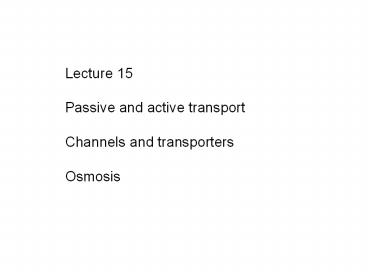Passive and active transport - PowerPoint PPT Presentation
Title:
Passive and active transport
Description:
Lecture 15 Passive and active transport Channels and transporters Osmosis Diffusion across exchange epithelium Einstein eqn: - mean square distance (cm2) D ... – PowerPoint PPT presentation
Number of Views:107
Avg rating:3.0/5.0
Title: Passive and active transport
1
Lecture 15 Passive and active transport
Channels and transporters Osmosis
2
Diffusion across exchange epithelium
random walk
Einstein eqn
ltx2gt - mean square distance (cm2) D diffusion
coefficient (cm2/s) t time interval (s)
3
The Einstein relationship is non-liner
For a small molecule diffusing in the cytoplasm
D 0.510-5 cm2/s
x 1 mm t 1 ms x 10 mm t 100 ms x
100 mm t 10 s x 1 m t 107 s 3.2 yr
4
Ability to Move by Diffusion
substance MW r (nm) D cm2sec-1 µm in 1sec µm in 1 hour
water 18 0.15 2.0E-05 63.2 3795
oxygen 32 0.2 1.0E-05 44.7 2683
urea 60 0.4 1.1E-05 46.9 2814
glucose 180 0.5 7.0E-06 37.4 2245
RNAse 13700 1.8 1.0E-06 14.1 849
Hemoglobin 68000 3.1 7.0E-07 11.8 710
TMV 30,000,000 5.0E-08 3.2 190
vesicle 500 4.0E-09 0.9 54
mitochondrion mitochondrion 2000 1.0E-09 0.4 27
5
Diffusion across membranes
14C-glycerol
? J P C1
J P C2
Does rate change with C2?
?Jnet P ?C
6
The NET flux is the difference of the two
unidirectional fluxes
Independent diffusion
Single-file diffusion through a channel
Electric potential
DE
DE
where n is the maximal number of ions
interacting in the pore
H.H. Ussing, 1949
7
Permeation Through the Phospholipid Membrane
defect propagation or solubility diffusion
membrane Jnet P ?C
bulk Jnet D ?C/?x
8
e22-6
Born energy
e180
9
(No Transcript)
10
Enough to cause cell lysis
Poorly permeable
11
Flux with Force
0 5 10 15 20 25 mV (voltage f)
Electric field df/dx
Direction of force on ion?
Force causes.?
Acceleration?
Novelocity?
friction
Velocity, v Force mobility uForce
u is mobility
J v concentration ucForcegeneral flux
equation
12
Free Energy/ mole chemical potential (µdG/dc)
µ µo RT lnc zFf VP mgh .
For simple diffusion of uncharged substance z
0 P0 ignore gravity
same as Ficks Law if D uRT
13
Transportcatalyzed translocation across membranes
Simple diffusion is not a transport process
Passive energy independent
Active energy dependent
- Coupled to an energy source light, ATP, redox,
gradient - Transport against an electrochemical gradient
Equilibrium ?µS 0
Note S1 not necessarily equal to S2 at
equilibrium!!
14
initial
final
S1
-60 mV
-60 mV
S1
S1
S1out 1 mM S1in 0 mM
S1out 1 mM S1in 10 mM
Active or passive transport?
15
Equilibrium (reversal) potential
(Boltzmann)
(Nernst)
At 37oC
16
Which are passive?
17
Solute transport Channels and Facilitators
- Water channels (aquaporins)
- Intercellular gap junctions (connexins)
- Mitochondrial channels (ATP/ADP exchange)
- ABC transporters (MDR proteins, CFTR)
- Diffusion Facilitators Glucose transporters
(GLUT1-12)
18
Non-specific water-filled channels Example
Bacterial PORIN, OmpF
Water-filled pore
(the first crystallized membrane protein,
b-barrel)
19
Porin OmpX
Permeation of solutes by size and/or charge
20
MscL open
MscL closed
WT MscL has one single Tyrosine (Y) per subunit
in position 79. If we insert second aromatic
residue (Y or W) in position 93, the channel
becomes non-functional. If we move the second Y
(or W) to position 102, this partially rescues
the defect.
(from Chiang et al., 2005)
21
Gap junctions
connexins
(from Sosinsky)
22
Gap Junction Channel
From Unger et al., 1999
23
Oocyte injected with aquaporin mRNA
24
C1 C2
C1 gt C2
C1 gt C2
H2O
P1 P2
P1 gt P2
P1 P2
Water flows into the left compartment through the
semi-permeable membrane down its own
concentration gradient. It tends to dilute the
contents of the left compartment raising the
level of fluid at the same time. The increased
hydrostatic pressure eventually counters the
water influx and at equilibrium the net water
flow is zero.
25
Equilibrium is achieved quicker if we close the
left compartment
Hydrostatic pressure difference at equilibrium
P2-P1 RT(C2-C1)
Osmotic pressures of individual solutions
p1 RTC1
p2 RTC2
A difference of C 1 mOsm creates pressure of
18.4 mm Hg 100 mOsm is equivalent to 1840 mm Hg
or 2.42 atm
26
Aquaporins and aquaglyceroporins
27
Aquaporin water channel
The salient property of aquaporins is that pass
only water (occasionally glycerol), but NO ions!
From Agre and Kozono, 2004
28
The Grotthuss mechanism Proton-hopping mechanism
is prevented in aquaporins by strict orientation
of water in each half of the channel
Proton has abnormally high mobility in water and
other dissociating fluids because it does not
diffuse all the way, protons are re-distributed
by binding and dissociation.
Cation Mobility cm2 V-1 s-1 in
water NH4 0.76310-3 Na 0.51910-3 K 0.762
10-3 H 3.6210-3
T. Grotthuss, 1806































